|
Pre-Harvest Corn Disease Scouting Observations
DR. KIERSTEN WISE
PRINCETON, KY.
Scouting reports across Kentucky this week have indicated that farmers need to be aware of stalk rots and ear rots as they prepare for and begin corn harvest. Pockets of fields scouted across the state have stalk rot issues that range from minor to severe; in some cases causing pre-harvest lodging (Figure 1).
A variety of ear rots have been observed across the state as well. It is important to identify fields that may have stalk rot and/or ear rots to ensure timely harvest, proper storage of moldy grain, and determine the potential for mycotoxin issues.
Stalk Rots
There are several fungi that can cause stalk rots, and often samples need to be observed in a diagnostic laboratory to confirm the cause of the stalk rot. Stalk rots can cause yield losses from lodging and stalk breakage. In 2020, several fields across the state have exhibited premature senescence and top dieback, similar to symptoms of anthracnose top dieback.
Anthracnose and Diplodia Stalk Rots
Anthracnose top dieback is a phase of anthracnose stalk rot, caused by the fungus Colletotrichum graminicola. Anthracnose top dieback is commonly observed in late grain fill as bleached or yellow leaves and stalks appear in the upper canopy while surrounding plants are still green (Figure 2).
Symptoms typically appear just prior to senescence, although symptom expression differs among hybrids. Lesions of anthracnose generally appear as long, narrow, brownish-black streaks or lesions on the surface of the stalk; older lesions are darker and may be shiny in appearance and extend into the rind of the stalk. The internal tissues of the stalk, or pith, may also have brownish discoloration that will be hard to distinguish from other stalk rots, like Diplodia stalk rot, which is another common stalk rot in Kentucky. Diplodia stalk rot can also result in premature senescence and plant death during grain fill (Figure 3), so an accurate diagnosis of the causal stalk rot it is important.
The fastest way to get a diagnosis is to submit samples to a local county Extension office for testing at a Plant Disease Diagnostic Laboratory.
Stalk Rot Management
Scout fields prior to harvest to determine if stalk rots are present and if lodging is a concern. Fields that have moderate to high levels of stalk rot or stalk breakage should be harvested as early as possible to prevent lodging and yield losses. The fungi that cause anthracnose stalk rot and Diplodia stalk rot overwinter in crop residue, and the disease is more severe in corn-on-corn rotations. Resistant hybrids are available, and farmers can also choose hybrids with good stalk strength ratings. A combination of resistant hybrids, crop rotation, minimizing in-season stresses, and early harvest are recommended to prevent yield loss from these diseases.
Ear rots
Several different fungi cause ear rots. Environmental conditions at silking, just after silking, and prior to harvest influence which ear rot may be problematic in a given year. Additionally, the fungi that cause Gibberella ear rot and Fusarium ear rot produce mycotoxins as a byproduct of the infection process.
Diplodia ear rot
Diplodia ear rot is caused by the fungi Stenocarpella maydis and S. macrospora. These fungi survive in residue and infect plants shortly after pollination. Humid weather and rains prior to and after pollination will favor disease development. Diplodia ear rot is identified by white fungal growth on the cob, often forming a mat of fungus across the ear (Figure 4).
Infected kernels may also be brown-gray in appearance. Small, black fungal structures called pycnidia may form on the kernels or the cob. The fungus is reported to produce a mycotoxin called diplodiatoxin in South America and South Africa; however, no reports of toxic effects of grain on livestock or humans due to Diplodia ear rot have been reported in the United States. Grain dockage may still occur, however, due to moldy grain. More information on Diplodia ear rot can be found in a University of Kentucky publication (PPFS-AG-C-05).
Fusarium ear rot
Fusarium ear rot is primarily caused by the fungus Fusarium verticilliodes. This fungus infects corn after pollination, and infection is favored by warmer temperatures. Fusarium-infected ears may have white to purple fungal growth on the cob, or symptoms may appear as discolored kernels scattered throughout a cob or associated with insect feeding (Figure 5).
Visible fungal growth may not be obvious on the cob, but a white “starburst” pattern in kernels can sometimes be observed on ears infected by this fungus. The mycotoxin fumonisin is associated with Fusarium ear rot.
Gibberella ear rot
Gibberella ear rot is primarily caused by the fungus Fusarium graminearum, which also causes Fusarium head blight of wheat. This fungus infects corn during early silking, and also forms a white mat on the cob like Diplodia ear rot, but often with a pinkish color (Figure 6). The fungal mat typically begins at the ear tip and progresses down the cob. This ear rot is less common in Kentucky because the fungus prefers cool, wet weather after silking to infect ears. Pockets of Kentucky had cooler than normal temperatures at and after silking this year, and those areas should be aware that this ear rot can be present and may be a mycotoxin risk. The mycotoxins deoxynivalenol (DON; vomitoxin) and zearalenone are associated with the fungus that causes Gibberella ear rot.
Ear rot management
Regardless of which ear rot is present in a field, farmers should scout fields prior to harvest and determine the level of incidence of any ear rot in the field. If ear rots are observed in a field, affected areas should be harvested early and grain segregated to avoid contamination of non-infected grain. Grain harvested with suspected ear rots should be dried to below 15 percent moisture. If grain is stored above this moisture content, mold can continue to grow, and any mycotoxins present can continue to accumulate in grain. All grain contaminated by any ear rot fungus should be stored separately from good grain; if stored long term, store below 13 percent moisture to prevent further growth of fungi. If ear rots that are associated with mycotoxins are suspected, send grain or silage samples to a testing laboratory prior to feeding.
Several publications on ear rots and mycotoxin management are available through the Crop Protection Network. These publications provide information on ear rot identification and management, mycotoxin testing, as well as answers to frequently asked questions about mycotoxins and storing moldy grain. ∆
DR. KIERSTEN WISE: Extension Plant Pathologist, University of Kentucky
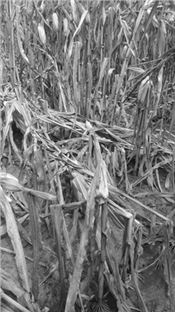
Figure 1. Lodging caused by stalk rots
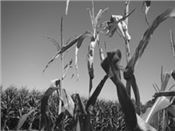
Figure 2. Anthracnose top dieback
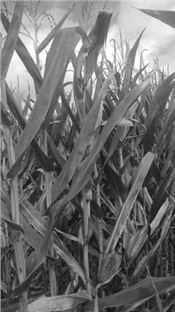
Figure 3. Premature plant death caused by Diplodia stalk rot
Photo courtesy Kiersten Wise, UK
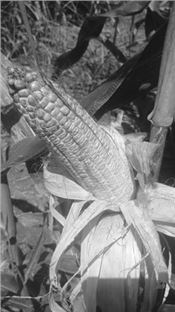
Figure 4. Diplodia ear rot
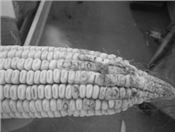
Figure 5. Fusarium ear rot
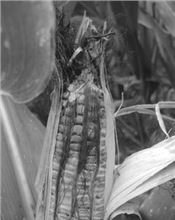
Figure 6. Gibberella ear rot
|
|